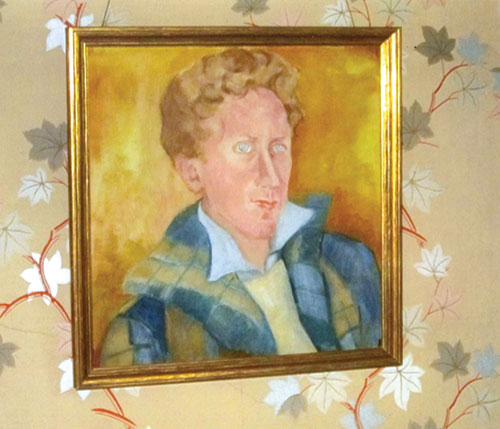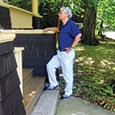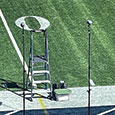Dreams do come true. One dream of mine was seeing the Percy Grainger home at 7 Cromwell Place at White Plains, New York. I left on my musical pilgrimage from my home in Wellington, Ohio on a rainy Tuesday morning bound for White Plains nine hours away. In anticipation of my trek I reread John Bird’s excellent biography of Percy Grainger to refresh my memory of Grainger’s life. I gathered all my favorite Grainger CDs, cranked up the sound of my Bose speakers and drove off to White Plains.
For many of us, studying the life and music of Grainger has greatly influenced and stimulated our musical growth. I still have chills run down my spine when I listen to Grainger’s perfectly crafted harmonies and emotional melodic climaxes found in Lincolnshire Posy, Irish Tune from County Derry, and Colonial Song. After conducting his music for over forty years, I still find hidden treasures of indescribable beauty that reconnect me to my humanity. For me, the most lasting gift that Grainger teaches is that is okay to feel music deeply and never be afraid to express those deep spiritual emotions that lie close to the heart.
Looking southward while driving across the wide Hudson river on the Tappan Zee bridge afforded a stimulating view of New York City. My appointment to see the Grainger home was not until Wednesday, so I spent Tuesday night at Tarrytown a few miles outside White Plains.
The Grainger home is easy to find. I followed Tarrytown Road, (Highway 119) east to Main Street, right on Lexington Ave and left on Post Road, quickly sighting 7 Cromwell at the top of a hill. This was Percy Grainger’s home from 1921 until his death in 1961. Grainger would get to his house after arriving at White Plains train station from Grand Central Terminal in New York by taking a brisk walk of about a mile to his home, often pushing his baggage, books, and scores in an old flat wooden wheelbarrow.
Looking up from the street to Grainger’s home, one has to climb a number of steps before arriving at the wide front porch supported by four white columns. Grainger would display his excellent athleticism by hopping up these front steps on one leg and then down on the other leg. Getting ready to climb the last few steps to Grainger’s home I became excited about the possibilities I would soon find. I could almost imagine Percy Grainger and Frederick Fennell sitting there discussing the interpretation of Lincolnshire Posy.
The tour guide, Susan Carlson, who was originally from Dayton, Ohio, and now a lawyer living in White Plains was cheerful and friendly as she invited me into the home. Before entering we stood on at the door and read the simple plaque:
“7 Cromwell Place, White Plains, New York. Completed in 1893, and for forty years (1921 -1961) the Home of Percy Grainger, Distinguished concert pianist and composer. Westchester County Historical Society 1982.”
The Percy Grainger home, built in 1893 by David Cromwell, is an imposing two-story sitting majestically upon a stone base standing atop a hill that would have once commanded a wonderful view of White Plains. Grainger bought the home in 1921, after he was encouraged by his neighbors to move from his apartment in New York City to a place more tolerant of his long hours of practice at the piano. He moved into this large house with nine rooms, an attic, and a basement with his mother, Rose, in April 1921 and this was to be his home for the rest of his life.
The home is very much like Grainger left it in 1961, and one can almost feel his spirit bouncing from room to room, singing County Gardens. Entering the house, one steps back in time over a century ago with the furnishings similar to 1893. Inside, surrounded by his memorabilia, there is something almost mystical that brings his memory back alive. The house is a veritable treasure trove.
Inside, I walked first to the large table in the dining room, where I knew Grainger laid out the pages of his scores as he worked on various parts. Susan pointed out that the light fixtures, original to the house, had been installed with thought to the future, primed for both gas and electricity. Instantly I conceived an image of Grainger bent over his manuscripts, the lights dancing his shadow upon the walls.
A shadow of sadness resides here in the home, as we recall Percy’s strong relationship with his mother, Rose. Many of her dishes still remain on the shelves of the pantry cabinet. Only a year after moving here, Rose’s mental and physical health began to worsen. On April 30, 1922, when Grainger was touring on the West Coast, Rose traveled to New York City and jumped to her death from an office window on the 18th floor of the Aeolian Building. After Rose’s funeral Grainger left for a year long trip where he collected and recorded Danish folk songs and also visited Frederick Delius in Norway. Grainger returned to White Plains in 1923 where he continued to compose and give piano recitals.
Coming back from a tour of Australia in 1926 on board the ship Aurongi, Grainger met his future wife, Ella Viola Strom. They married two years later on August 9, 1928 and the wedding ceremony was held during the intermission of a Grainger concert in front of 20,000 people at the Hollywood Bowl.
Grainger composed an orchestral tone poem To a Nordic Princess for Ella as a wedding gift, which was performed by 126 players at the ceremony, the largest orchestra yet to have played at the Bowl. Grainger declared that getting married to Ella was the best thing he had ever done in his life.
Ella was both a poet and artist who lived with Grainger from the time of their marriage until his death in 1961. Ella was of immense help to Grainger both as an inspiration and performer. She learned to play bells, marimba, and the xylophone for his music and can be heard on the Stokowski recording of Granger’s music. After Grainger died, Ella continued to live at 7 Cromwell Place until her death there at the age of 90, and her presence is evident in every room throughout the house.

Oil painting of Percy Grainger, by his wife, Ella.
It is especially thrilling to explore the music room. Above the beautiful Steinway is Ella’s large, colorful oil painting of Grainger. Throughout his life Grainger often preferred an upright piano for the hard touch he sought for certain effects, and here in the room is one that belonged to his lifelong friend, composer Cyril Scott. There is also Grainger’s harmonium, which was used for other desired effects. On the wall are framed photographs of composers Edvard Grieg and Frederick Delius, two major influences on Grainger’s musical development, and a bronze table presented by the National Music Council stating: “Home of Percy Grainger 1882-1961, the celebrated Australian-Pianist and composer who made his home in White Plains until his death.” Before moving on in my tour I sat for a moment beneath Grainger’s gaze at the grand piano and played the theme from Irish Tune from County Derry, the music that introduced many of us to the magical musical world of Percy Grainger.
In the hallway before the partition into the living room I reached up and touched Grainger’s chinning bar, another example of his passion for physical fitness.
.jpg)
Grainger, passionate about fitness, had a chin-up bar installed near his living room.
Walking up the stairs I passed a beautiful Tiffany window, which adds charm to this home. The second floor contains the separate bedroom of Percy and Ella and a third guest room where the composer Henry Cowell once stayed. The rooms contain many individual mementos like medicine bottles, hats, and several paintings and sketches by Ella. What I found most striking were three butterfly collections, the colors still vivid and fresh, after years behind glass.
We went up more stairs for a quick look at the attic, which still holds items stored by the Graingers and even earlier, by the Cromwells. It seemed that the complete lifetime of this house has been preserved.
Preservation of his life’s work was paramount in Grainger’s mind because he had a room in the basement built to be fireproof and there he stored his compositions and scores. It is filed and sorted, held here in trust, even as his works are also housed in the Library of Congress. In other rooms of the basement are boxes of his letters, pamphlets from concerts, records, and sheet music. Here, volunteers of the Grainger Historical Society face a fascinating and daunting task to organize and catalogue all these innumerable items. I believe that Grainger would be proud of the interest, dedication, and love evident toward him. Incompre-hensible to us today, in his last years, Grainger considered his career a failure. He said, “All my compositional life I have been a leader without followers.” His failure to be recognized as a composer for anything beyond his folksong arrangements was a source of frustration and disappointment to him.
Grainger died of prostate cancer in the White Plains hospital February 20,1961 at age 78. His body was flown to Adelaide, Australia, where on March 2, he was buried in the Aldridge cemetery, alongside ashes of his mother Rose. His epitaph reads, “Lover of mankind, art & nature.” On his tombstone, “George Percy Grainger, world famous composer and pianist, dearly beloved husband of Ella Grainger. Born July 24,1882. Died 20th February, 1961.”
Sources
Percy Grainger by John Bird (London: Faber & Faber, 1982).
7 Cromwell Place: A Loving Tribute to Percy Grainger by Inez Bull (Ole Bull Historical Society Publication, reprinted 1996).
“Conversations With Ella Grainger” by David Josephson (The Grainger Society Journal, Volume 11, Number 1, July, 1993, pp 3 – 90).






